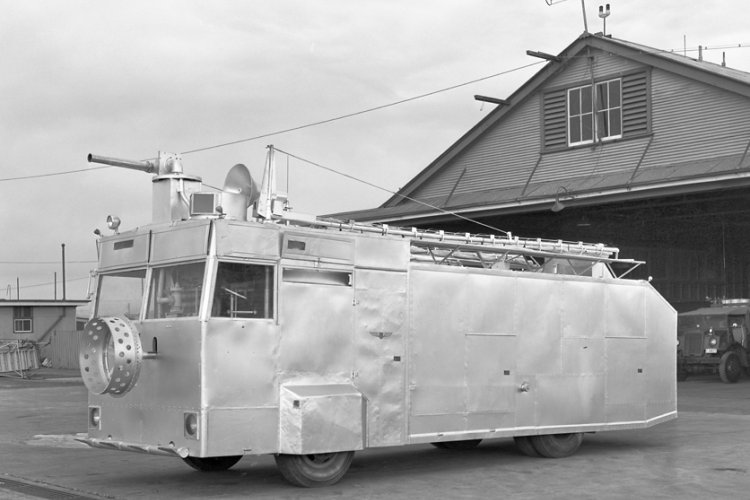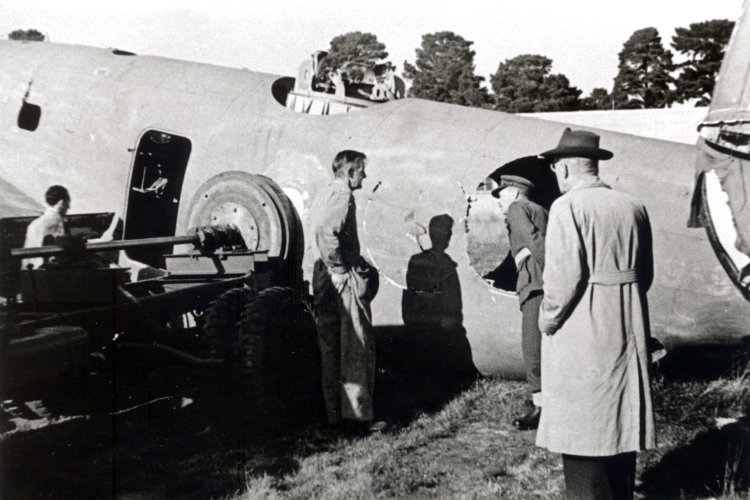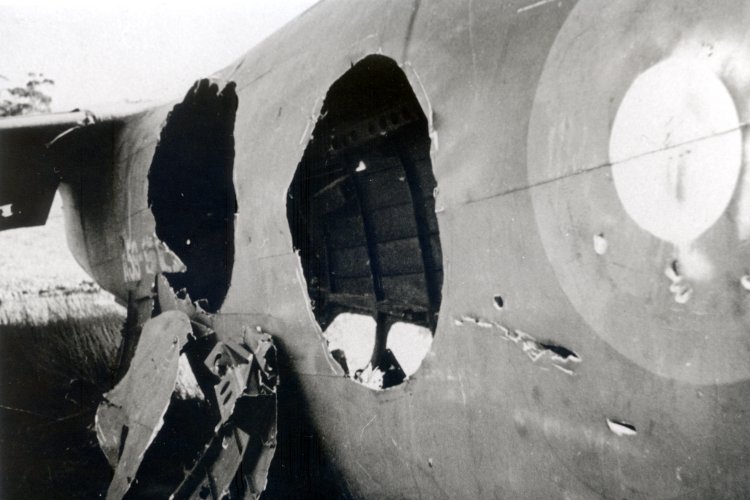The
following article appeared in the January 2011 edition of Aeroplane.
It is reproduced here with the permission of the author, Phil
Vabre.
The
Monegeetta Monster
by
Phil Vabre

The
Monegeetta Monster at Essendon. (Picture: CAHS G25)
In
the late 1940s the Australian Department of Civil Aviation (DCA)
fire service was equipped mostly with war-surplus, ex-RAAF appliances.
Most of these were of very limited capability and, with larger
passenger aircraft entering service, during 1948 DCA embarked
on an ambitious program to design an advanced experimental fire
tender.
The specifications were laid down by DCA Mechanical Engineer Marshall
Fordham. A commercial rear-engine REO bus chassis was purchased
for the construction of the vehicle but, lacking any suitable
facilities, DCA engaged the Department of Army's Experimental
and Proving Establishment at Monegeetta to design and construct
a body and equipment to meet the DCA specifications. The Army
Experimental and Proving Establishment had been set up during
the Second World War at Monegeetta, north of Melbourne, to conduct
trials on all kinds of military vehicles and had the engineering
capacity to work on the experimental fire tender.
The vehicle that emerged was like no other fire tender before
(or since!). Looking more like a cross between an armoured car
and a 1940s science-fiction space-ship than a fire tender, it
became known from that time forward as the Monegeetta Monster.
Conceptually, the vehicle was very advanced and contained a number
of novel features that would later become standard on aviation
fire tenders. Unlike standard appliances of the day, the 'armoured'
aluminium body was designed to allow the vehicle to approach right
up to a burning aircraft whilst shielding the operators inside.
The driver sat on the right and protective steel shutters could
be lowered over the windows, leaving only a narrow slit for vision.
A roof-mounted, trainable monitor could discharge foam at some
distance, while under-body sprays discharged foam on the ground
immediately ahead of the vehicle, suppressing any fuel fire as
the vehicle approached the aircraft. The monitor operator sat
on an elevating motorcycle saddle and, when the shutters were
down, looked out through an armoured cupola on the front left
roof of the vehicle.
A unique feature of the Monster was a special large-diameter hole
saw. This was mounted on an extensible shaft on the front of the
vehicle and was designed to cut a hole in the side of an aircraft
and withdraw the section of aircraft skin, thus creating an emergency
exit. To develop this innovative tool, a test rig was built with
a prototype of the saw mounted on the back of a war-surplus army
truck. The substantial remains of Lockheed Ventura A59-90 were
issued to DCA, along with Ventura A59-63, and trucked to Monegeetta
where the test rig was used to cut holes in the fuselage. The
trials showed that the thin aircraft skin tended to tear badly,
a problem that was cured by using a smaller-diameter saw on the
Monster. In tests, the cutting time was 1 to 2 seconds.
Another unique feature of the Monster was the provision of two
asbestos 'curtains' mounted on horizontal booms on either side
of the hull. These booms could be swung forward through 180 degrees
and the furled curtains released, forming a protected corridor
between the emergency exit the Monster had just created and the
vehicle itself, into which crash survivors could emerge safely.
The Monster was completed in about 1950, though the exact date
is not recorded. It underwent various trials at Monegeetta before
being based at Melbourne/Essendon Airport, at that time the Southern
Hemisphere's busiest civil airport. The trials culminated in December
1955 with a filmed demonstration for the press and VIPs at RAAF
Laverton, then on the south-western outskirts of Melbourne.
The Fire Service Branch of DCA had been formally created earlier
in 1955. Following severe criticism of the airport fire service
response to the crash of BOAC L-749A Constellation G-ALAM at Singapore's
Kallang Airport on 13 March 1954, the Director General of Australia's
Department of Civil Aviation, Sir Richard Williams, placed a minute
on file in the latter part of 1954 directing that if the Department
was to have a fire service, it had to be established on formal
lines and be an efficient operational service, and not be subject
to criticism as in the Kallang affair. The December demonstration
was intended to show off the capabilities of the new Fire Service
Branch.
For the Laverton fire-fighting demonstration, the Monster's 'victim'
was Avro Lincoln RF423. Having recently been struck off RAAF charge,
the aircraft had its engines removed and the undercarriage retracted
in preparation.
The demonstration commenced with one of DCA's new Land Rover-based
Light Rescue Tenders dealing with a simulated engine fire. While
members of the fire crew attacked the fire with light hand lines
and portable extinguishers, another Firefighter used a hand-held
circular saw to cut a hole in the aircraft's skin.
Then it was the Monster's turn. A larger simulated fuel-tank fire
gave the shining, silver Monster an opportunity to show off its
foam-spraying abilities as it closed on the rear fuselage of the
Lincoln. The hole saw shrieked as it bit into the skin of the
aircraft and in seconds the Monster was pulling away, leaving
behind a neat, circular opening in the fuselage. A rather protracted
process of winching out the booms and unfurling the asbestos curtains
culminated the demonstration. For good measure, the whole evolution
was then repeated on the nose of the aircraft.
The December 1955 demonstration was probably the Monster's high
point. Unfortunately, the vehicle overall was not a great success.
For one thing the asbestos curtains became very heavy when saturated
with foam, causing the booms to buckle. The commercial bus chassis
would also have severely limited the vehicle's off-road performance,
despite the weight-saving aluminium bodywork. The innovative hole
saw was fine for military aircraft with relatively small crews,
where it was unlikely that a crewman would be adjacent to the
fuselage at the cutting point, but would have been deadly cutting
into a fuselage full of passengers.
In the event, DCA purchased more conventional fire-fighting appliances
and the Monster faded from the limelight. The vehicle remained
at Essendon, eventually finding its way into storage in one of
DCA's workshops where airways engineering apprentices were sometimes
sent to saw off bits of the aluminium bodywork to make chassis
for radio equipment. The ultimate fate of the Monegeetta Monster
is not known, but it would be years before some of the innovative
features of this brave attempt to create a truly modern aviation
fire fighting appliance, such as the roof-mounted foam monitor
and under-body sprays, became standard equipment.
Monster 'victims'
Lockheed L-137-27-01 Ventura Mk V A59-90 was built to a US Navy
order as a PV-1, Bu 49440. Diverted to the RAAF, it departed the
west coast of the USA on 12 April 1944 on ferry to Australia via
the Pacific. It was received by the RAAF's 2 Aircraft Depot, Richmond,
exactly a month later. The aircraft did not see squadron service
but its undercarriage collapsed on takeoff at RAAF Laverton on
30 April 1945. The substantial remains were issued to DCA in April
1948, along with Ventura A59-63, and trucked to Monegeetta where
they were used for hole-cutting tests.
Ventura A59-63 was also built to a US Navy order and allocated
the serial Bu 34995. Ferried to Australia in December 1943, it
was allocated to 13 Squadron RAAF and converted as a transport
with the radio callsign VHRGR. It, too, was issued to DCA in April
1948 and used in tests at Monegeetta.
Avro 694 Lincoln B Mk 2 RF423 had previously served with 44 Squadron
RAF, coded KM-K. It was one of many RAF Lincolns to come to Australia
in the late 1940s and early 1950s on various trials and support
work. At least nine RAF Lincolns were taken over by the RAAF,
and RF423 was one of these. It was brought on RAAF charge on 3
April 1952 and allocated to the Aircraft Research and Development
Unit (ARDU) Trials Flight, then based at RAAF Laverton. The aircraft
was struck off charge on 22 March 1955 and issued to DCA on 11
November that year.
Phil Vabre is Vice
President of the Civil Aviation Historical Society, which operates
the Airways Museum at Essendon Airport, Melbourne, Australia.
Phil would like to thank John Hopton, Maurice Austin and Ron Cuskelly
for their assistance in preparing this story. See www.airwaysmuseum.com
for more information.
|





